Remember you have to be a member of the N Gauge Society to purchase our kits
Kit No. 1: BR Hopper Wagon HJO/HJV
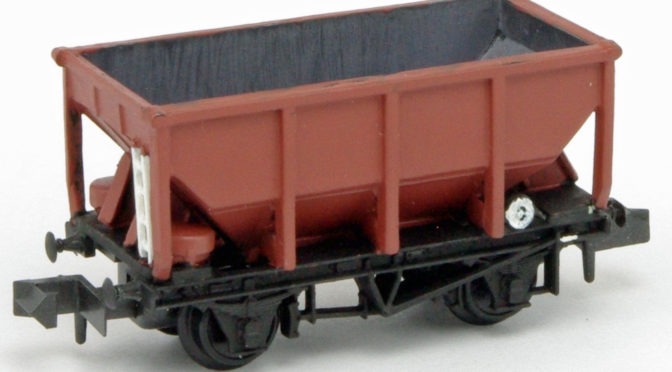
- NGSK0010
- era 4-7
- decals=NGST0010
- difficulty- beginners
In 1955-9 BR built over 2000 25.5 ton iron ore hoppers to D1/163, D1/165 (vacuum fitted and only rated 24T), and D1/166. Later some were used for coal, sand, and limestone, or converted to carry salt. It is a very simple kit to make, fitting on the supplied Peco 10 ft chassis, though it is not to the same standard as some of the later kits.
Kit No. 2: GWR/BR Mink ‘C’ Van

- NGSK0020
- era 2-5
- decals=NGST0020
- difficulty intermediate
The GWR built 425 of these vans in 1906-7, and some lasted into BR days. They could work in passenger trains and could carry fruit as well as general goods. It is slightly more difficult to construct than some kits as the included Peco Parkside chassis has to be assembled. The kit is a good basis for conversion into other similar GWR vans.
Kit No. 3: MR/LMS/BR Outside Framed Van
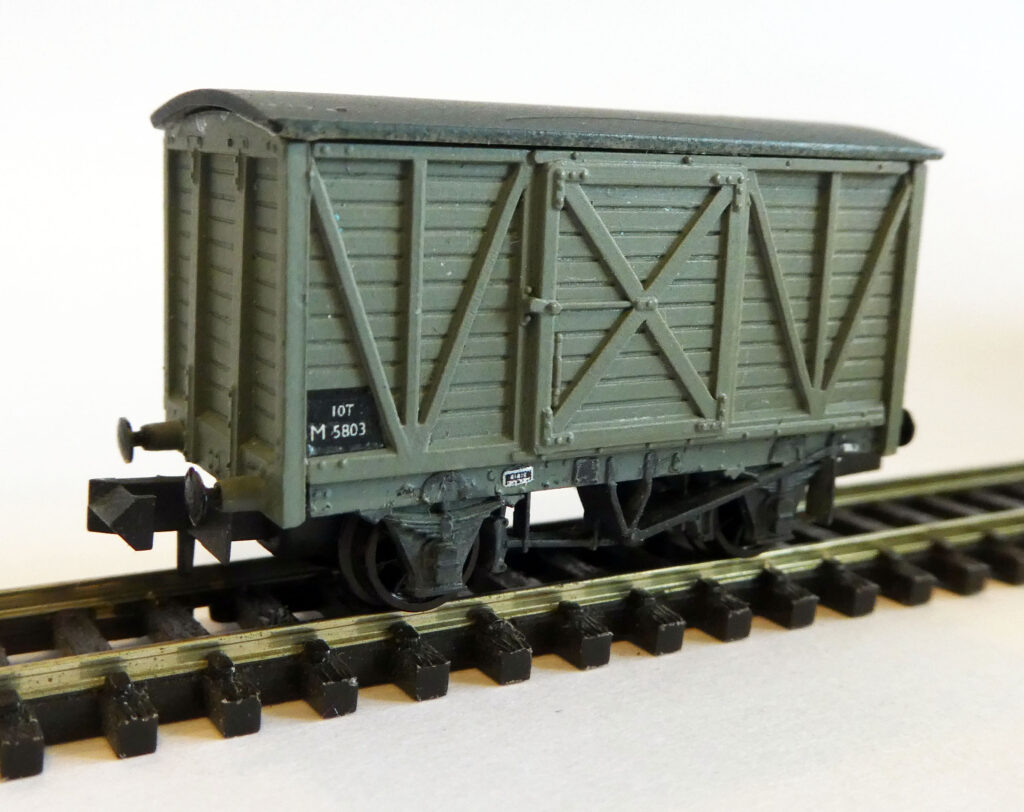
- NGSK0030
- era 2-4
- decals=NGST0030
- difficulty beginner
The Midland Railway built about 7,000 of these vans between 1883 and 1916 (with some minor variations). Some of these vans survived into BR days. Until around WW1 almost all vans were built with the wooden framework on the outside, making them very distinctive compared with later vans which had the frames inside leaving the outside smooth. Assembly is straightforward, although minor modification is required to the Peco 10ft wheelbase wooden solebar chassis (included).
Kit No. 6: GWR/BR ‘Loriot’ 4-wheel Wagon

- NGSK0060
- era 2-5
- decals=NGST0060
- difficulty intermediate
The GWR (and later BR) built many wagons similar to this for carrying machinery, BR coded them LOMAC (Low Machinery). It is simple to assemble, and an ideal wagon to carry interesting loads. There were dozens of slightly different designs, the 510 built by BR were to 14 different diagrams, and the prototype of this kit was literally unique – only one was made!
Kit No. 8: LMS/BR Bogie Bolster D

- NGSK0080
- era 4-7
- decals=NGST0080
- difficulty beginner
This is a model of the LMS version of the LNER design represented by kit 12, differing mainly in the bogies (diamond frame) and brakes. The LMS/BR built 216 between 1947 and 1949. They were used for carrying rail and steel. It is an easy kit to build.
Kit No. 9a: Polybulk Grainflow Hopper

- NGSK0090
- era 8-9
- decals=included
- difficulty advanced
It should be stressed that this is a complex kit, and should not be tried as a first experience of wagon building.
These 30 hoppers were built for TSL in 1981 to a French design for transporting bulk grain. Plastic mouldings are provided for the main body parts and Society one-piece bogies are included. Very fine brass etchings are also provided for delicate items like handrails etc. The full-colour bodyside overlays have the Polybulk logo and all other letterings, so painting is limited to the basic body colour and touching in buffer heads etc. The logo is the version used from 1988.
Kit No. 9b: Polybulk Distillers Hopper

- NGSK0091
- era 8-9
- decals=included
- difficulty advanced
Following the original ‘Grainflow’ version, this variant represents 30 wagons built for the Distillers company in 1983. It includes printed sets of sides for the two different brandings, Scottish Malt Distillers Ltd and Distillers Company Cereals Ltd. The traffic ceased in 1991.
Kit 10: GWR/BR Mica Meat Van

- NGSK0100
- era 2-4
- decals=NGST0100
- difficulty intermediate
The GWR built 120 Mica ventilated vans for meat 1887-1904, and 650 of the insulated version Mica B 1887-1926 with an ice hatch on the roof and rails. In 1938 at least 35 were converted to Tevans (no hatch or rails). Examples of all types survived to pass to British Railways. The kit makes one of any of these vans. Assembly is straightforward, although the Peco 10ft steel chassis supplied requires slight modification and the Mica B version has complex handrails giving access to the roof hatches at both ends, but notes and drawings are provided on how they must be shaped and fitted.
Kit 11: BR ‘Seacow’ Bogie Ballast Hopper

- NGSK0110
- era 7-9
- decals=NGST0110
- difficulty advanced
BR built 460 of these wagons in 1971-4. They lasted well into the 21st century, though the basic design dates back to 1903! The kit comes with etched details to build to a highly detailed model, though it is possible to omit some of the details if you want a simpler kit.
Kit 12a: BR BDA Bogie Bolster D

- NGSK0120
- era 7-9
- decals=NGST0120
- difficulty beginner
This kit represents the rebuilds in 1977-81 of many of the Bogie Bolster D wagons with air brakes and new Y25C bogies. It is an easy model to assemble.
Kit 12b/c: BR BDV/BDW Bogie Bolster D

- NGSK0121 & 0122
- era 5-9
- decals=NGST0121
- difficulty beginner
In 1958/9 a batch of 200 bogie bolster wagons were built with Davis and Lloyd 3-part bogies. Kit 12b is supplied with our Gloucester bogies (which are visually almost identical to the prototype versions). Kit 12b also covers a further 200 vacuum fitted wagons with Gloucester bogies built 1961/2. Kit 12c represents a further variant which ran on, and is therefore supplied with, Plateback bogies.
Kit 12d: BR BDO Bogie Bolster D

- NGSK0123
- era 4-7
- decals=NGST0080
- difficulty beginner
The commonest version of the Bogie Bolster D, over 2000 were built 1951 to 1957 with plateback bogies. Most were rebuilt 1977-81 (see kit 12a).
Kit 13: GWR/BR Iron Mink/Gunpowder Van

- NGSK0130
- era 2-6
- decals=NGST0130
- difficulty intermediate
This kit represents the Great Western ‘Iron Mink’ iron bodied general merchandise van, 4900 were built 1886-1901. They were particularly useful for transporting foodstuffs like flour, as the metal body gave protection from rodents. During WW1 some were converted to carry explosives, later converted back, and in 1937 60 were converted back again to gunpowder vans. Some of these were loaned to the SR and labelled ‘Improvised Gunpowder Vans’. Many of the normal vans were scrapped before WW2, but some were used for salvage collection branded ‘Salvage – Save for Victory’. Produced in plastic this is a very simple kit to build, though very minor modification is required to some of the chassis parts. The converted gunpowder vans differ from the purpose built GWR gunpowder vans (available RTR) in having rounded corners.
Kit 14: LNER/BR 8-plank Mineral Wagon

- NGSK0140
- era 3-5
- decals=NGST0140
- difficulty beginner
This is the LNER version of the standard RCH design 8-plank mineral wagon with a steel chassis. The SR in 1945 built 100 of these wagons for itself and 1850 for the LNER. The LNER built more in 1946, and before the war had built similar wagons on wooden underframes; there were private owner wagons to this design as well. Simple to assemble the kit builds into a fine model.
Kit 15: BR ‘Trestrol’ Bogie Well Wagon

- NGSK0150
- era 4-6
- decals=NGST0150
- difficulty intermediate
Three of these wagons were built in 1928 by the LMS, there were other fairly similar wagons to slightly different designs. It was used both with trestles (for carrying large sheets of steel) and without, trestles are available separately as a simple fold up etch. The kit is supplied with ready-to-run bogies making assembly straight forward.
Kit No. 16: BR 21t Hopper Wagon HTO/HTV

- NGSK0160
- era 4-7
- decals=NGST0160
- difficulty advanced
BR built 16,800 coal hoppers to design D1/146 between 1952 and 1958. The plastic kit fits on a (supplied) Peco Parkside 12ft wheelbase chassis. An etch has handrails at each end, footsteps, and hopper release handles: a jig helps you drill small holes for the rails which are then glued on, this is quite tricky but they can be omitted. Otherwise assembly is straight forward though some care is necessary, making this a kit for the more advanced modeller. The Dapol 21T hopper is the earlier version built 1949-55 with the stanchions angled at the bottom rather than straight.
Kit 18: LMS/BR 12t Box Vans

- NGSK0180
- era 3-6
- decals=NGST0180
This kit builds 2 LMS vans, one 9ft wheelbase and one 10ft wheelbase. The 9ft version has alternative ends for either a D1676 ventilated van (2956 built 1924-6) or a D1664 unventilated van (2544 built 1924-6). The 10 ft version builds the very common D1887 van, 7,500 built 1935-6. Both types remained in service into the 1960s, though the 10 foot vans lasted longer, many of the unfitted ones being fitted by BR. Assembly is straight forward, with only minor modification required to each chassis type before fitting to the respective body.
Kit 19: BR 21t Mineral Wagon
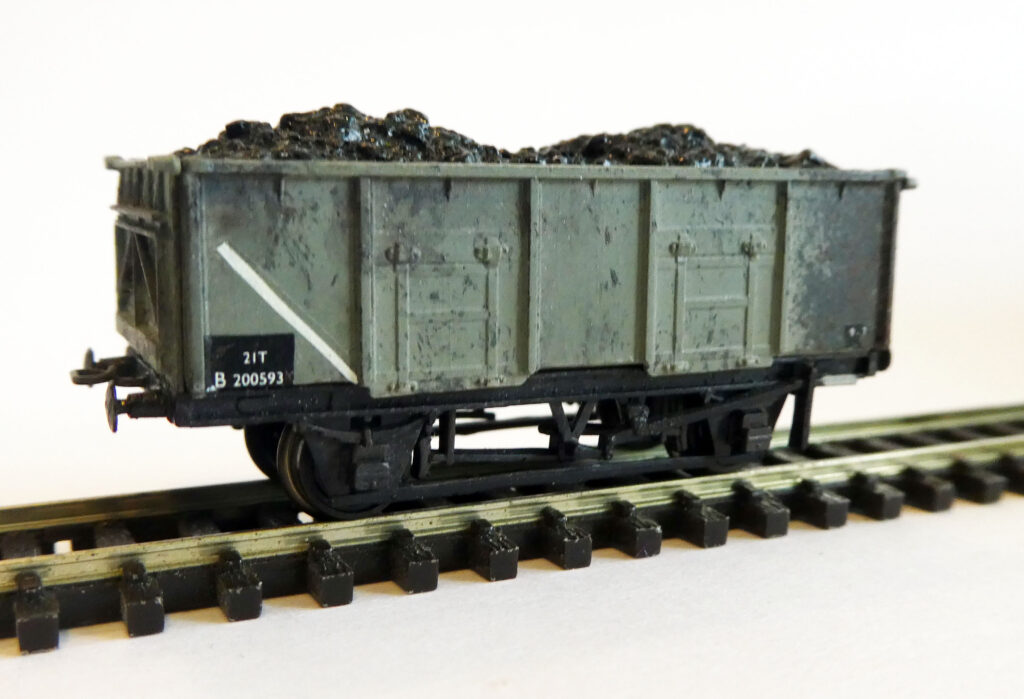
- NGSK0190
- era 4-7
- decals=NGST0190
- difficulty intermediate
BR built 1500 of these wagons in 1950. In 1971 a further 2600 similar wagons were built with new bodies on redundant 12 foot chassis. It is a simple plastic kit fitting on the supplied Peco Parkside 12ft wheelbase chassis. It is a reasonably simple kit to build. They often ran with other designs of 2-door mineral wagons.
Kit 20: BR ‘Anhydrite’ Hopper
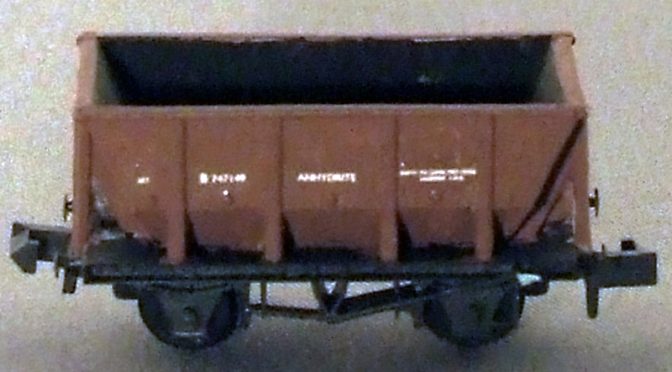
- NGSK0200
- era 4-7
- decals NGST0200
- kit difficulty beginner
- etch difficulty advanced
In 1954 BR built 150 of these 25-ton anhydrite hoppers to diagram D1/179 for traffic from the Long Meg quarry on the Settle and Carlisle line. They lasted until the early 80s. It is a very simple kit to make, fitting on the supplied Peco 10 ft chassis.
Kit 21: SR/BR 12t Box Vans Twin Pack
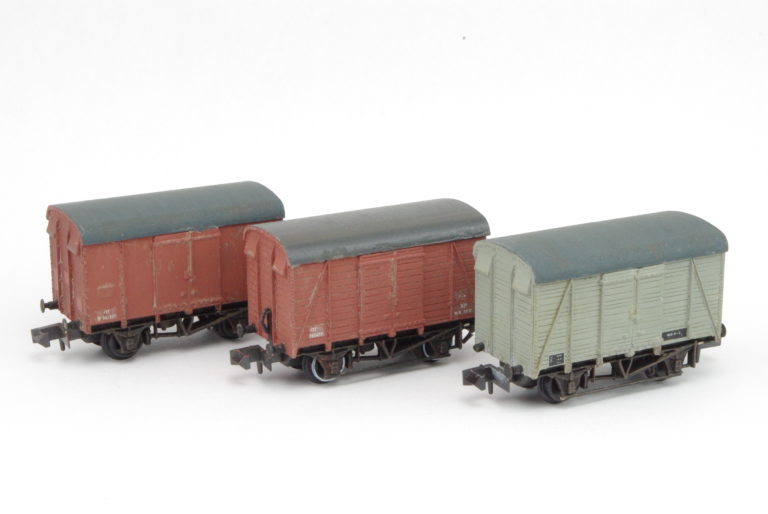
- NGSK0210
- era 3-5
- decals NGST0210
- difficulty beginner
This is the standard Southern Railway goods van with a 10 foot wheelbase and distinctive elliptical roof. About 1000 fitted vans were built 1936-38 with even planked sides, then 1936-42 another 1800 with uneven planked sides. Between 1942-4 the SR built unfitted vans with uneven planked sides on behalf of three companies: SR 1300, GWR 650, and LMS 400. Most were fitted after the war. From 1945-49 ply sides were used with 1,800 fitted vans built by SR/BR. The kit could easily be adapted to represent over 2000 vans built between 1927 and 1935 with the same even planked body but a 9 foot chassis.
Sufficient parts are included in each kit to allow the construction of two of three different variants: equal width planking on both ends and sides; unequal width planking on both ends and sides; and plywood sides and ends. This kit is produced in plastic and assembly is straightforward. Minor modification is required to the chassis before fitting to respective bodies, but this should be well within the average modeller’s capabilities.
Kit 22: BR ‘Shark’ Ballast Plough Brake
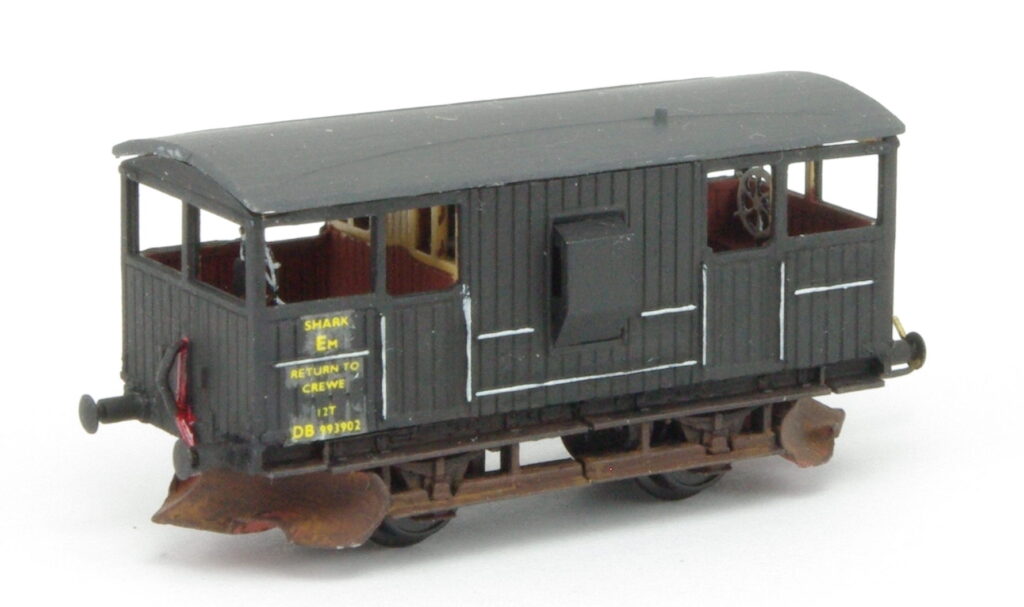
- NGSK0220
- era 4-9
- decals=NGST0220
- difficulty intermediate
BR built over 200 of these brake vans between 1951 and 1960. Vital to any permanent way ballast train, in addition to acting as a brake van it could spread the ballast discharged from the wagons by the use of special ploughs mounted underneath the veranda ends. It was common to have a Shark on each end of a train of ballast hoppers. While no longer needed as brake vans, some are still in use in 2020 as ploughs, and in the intervening years have received an enormous variety of liveries, reflected in the number of different markings provided on the associated sheet of decals.
The main kit parts for the body are produced in plastic with white metal castings for the ploughs and brass etches for the plough shields and operating handwheels. Assembly is therefore relatively straightforward though some quite extensive modification is required to the Peco guards van chassis provided. This kit must therefore be considered only suitable for those with some experience in wagon kit construction.
Kit 23: RCH/LMS 12t Open Wagon
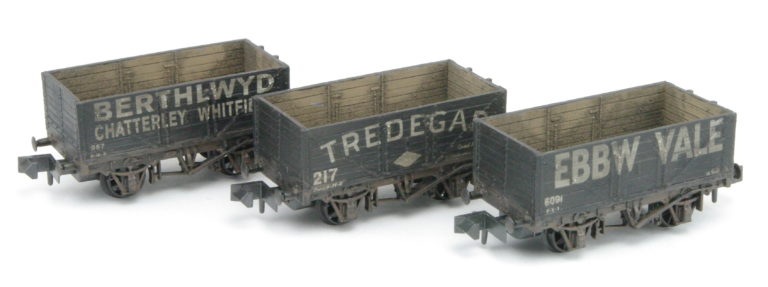
- NGSK0230
- era 3-6
- decals=Robbies Rolling Stock
- NGST0230 for additional BR markings
- difficulty beginners
The kit is of all plastic construction and is designed to be a direct fit on to the Peco 9ft wheelbase chassis provided. It is therefore eminently suitable for newcomers to model wagon construction. Alternative fixed ends are included in the kit to enable wagons without end doors to be represented. After the formation of British Railways they were absorbed and renumbered with P prefixed numbers.
The prototype for this model was a wagon built in its thousands to a standard design of the RCH (Railway Clearing House) for use by the many private traders of the time. Obviously “many traders” means many liveries, and this kit is therefore the perfect model for carrying these, often very colourful, liveries.
Kit 24: BR Standard Horsebox
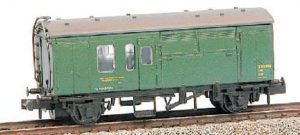
- NGSK0240
- era 4-5
- decals NGST 0240
- difficulty beginners
Following the 1948 nationalisation, the fledgling British Railways inherited large numbers of horseboxes of various designs, many dating from the pre-grouping period. To replace them, at first, BR built horseboxes to existing LMS or LNER drawings, but by the mid-1950s the decision was taken to produce a totally new vehicle, based on Mk.1 carriages then on the drawing board. In all, 115 BR Mk.1 Standard Horseboxes were built in 1957 and 1958.
No model of this type of vehicle having ever been available in N Gauge, the Society decided to produce this model as a memorial to the late Andrew Calvert, our former Wagon Projects Officer, who passed away in November 2002. Because of the number of parts in this kit it should be considered a model for those with some previous experience in building model wagon kits.
Kit 26: GWR Planked, Plywood & MOGO Vans
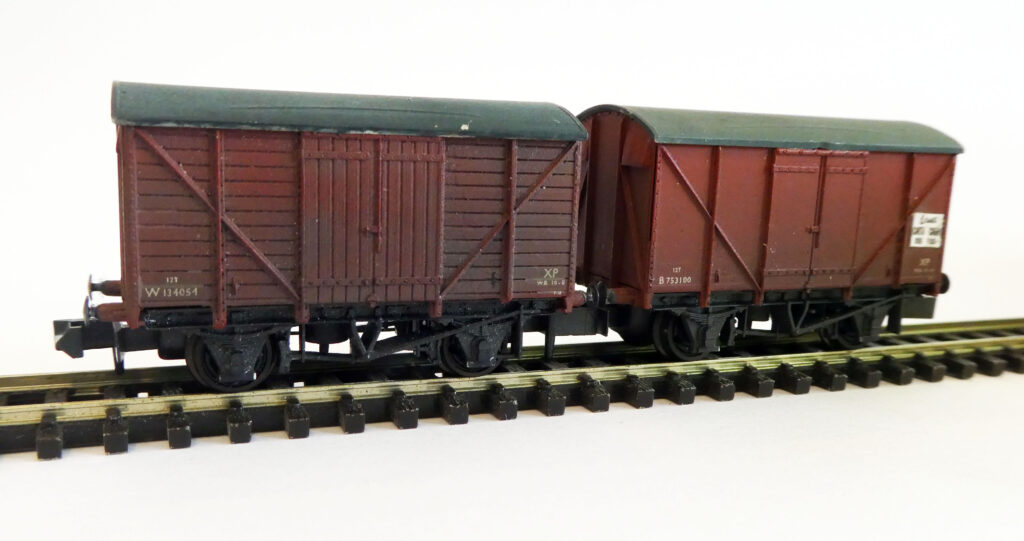
- NGSK0260
- era 3-6
- decals NGST 0260
- difficulty intermediate
From 1933 the GWR built more than 6000 ventilated vans with planked sides to designs V23 (fitted) and V24/34 (unfitted). A further 266 were built as PARTO vans to design V26, these having internal partitions to protect loads (e.g. biscuits) from being damaged during shunting. The GWR built 800 ventilated vans with plywood sides to design V36 (fitted) and V37 (unfitted) before nationalisation, with BR adding a further 330 following nationalisation. In 1935 the GWR built 350 MOGO (Motorcar Goods) wagons to design G31. These vehicles were almost identical to design V23 vans, except that they had doors built in the ends to facilitate loading of motor cars.
In 1947 a further 100 were built with plywood sides to a design G43, but these had planked ends. In service, unfitted vans were always common user (i.e shared between companies), with the fitted vans becoming common user from 1939. MOGOs do not appear to have ever been common user vehicles and were used mainly for sending new vehicles from factories to distributors, these being replaced by Carflats in the 1960s. This is an all plastic kit and features two different pairs of sides and three different pairs of ends, thus enabling models of any two of the prototypes to be built. Two Peco 10ft wheelbase steel solebar chassis are included in the kit as are suitable transfers. Because of the number of parts, this kit is considered a model for those with some previous kit building experience.
Kit 27a: BR ‘Salmon’ Engineers Wagon

- NGSK0270
- era 4-9
- decals=included
- difficulty intermediate
Based on an earlier LMS design, the first BR Salmon track carrying wagons emerged from Derby works in 1949 and over the next 11 years, hundreds were built to a variety of very similar drawings. The wagons are 62’ long, and as well as carrying loads of sleepers or lengths of rail, are designed to carry track panels in completed 60’ lengths. There are detailed rules governing the loading of Salmons. For track panels, when wooden sleepers are used, up to six can be loaded per wagon, while for concrete sleepers the maximum is five. Rail should be loaded on bolstered wagons and up to 27 lengths can be carried, loaded in pyramid fashion (ie 10, 9, 8). Although originally unfitted (YMO) or fitted with a through vacuum pipe (YMP), in later years the wagons were fitted with air brakes (YMA/YMB). Some were also fitted with cranes and, in some instances, roofs (YFA/YWA).
This kit includes a plastic body, etched brass details, one-piece plastic 8’ Plateback bogies, and transfers. Also available is a crane detailing kit containing a pair of cast resin cranes along with other details. The basic kit is fairly simple to assemble, although the addition of the detailing kit makes it more suitable for a modeller with a little more experience.
Kit No. 27b: YSA/YWA ‘Salmon’ post-1998
- NGSK0271
- era 9
- decals NGST0271
- difficulty intermediate
In 1998, a program to fit more modern bogies to the Salmons began in an effort to improve their reliability and enable faster running. The ASF bogies used look very similar to our Gloucester bogies which are supplied with this kit, together with a new decal sheet and reworked etched detailing parts. (See also kit 43 (NGSK0430) ‘Osprey’ track panel wagon conversion kit.)
Kit 28: RMC JGA Bogie Hopper
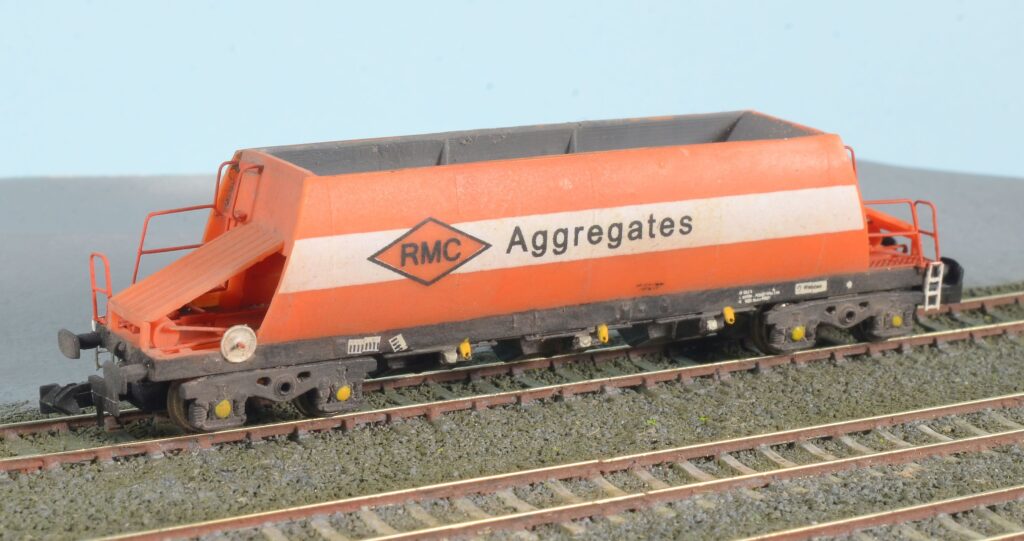
- NGSK0280
- era 8-9
- decals NGST0280
- difficulty advanced
13 wagons were built in 1984 to code JG009A for Hall Aggregates, and were used to carry sea-dredged gravel from Newhaven to Crawley and Tolworth. In 1986 a further 24 wagons were built to code JG009B for RMC, which operated on flows nationwide from their base at Peak Forest. In 1996, when the Newhaven traffic ended, the former Hall wagons were brought into the RMC pool at Peak Forest and were modified, refurbished and repainted. Now all 37 wagons are used with other RMC hoppers across the network.
This injection moulded kit, with etched brass details and one piece bogies, will build any of the three variants, suitable transfers for each being included. The model is self coloured in orange, and the white stripe is a transfer or can be painted. Otherwise only the brass details, the solebar and the interior require painting.
Kit 29: 7-plank Private Owner Wagon
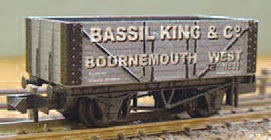
- NGSK0290
- era 2-3
- decals included
- additional decals NGST0230 for BR markings
- Difficulty beginner
This kit is yet another variant of the 1923 RCH wagon design for private owner wagons, this time with 7 planks and no end doors. It is a simple beginners kit using Peco’s 10ft chassis, with several liveries available (and many more possible).
Kit 30: Gresley D113 Full Brake
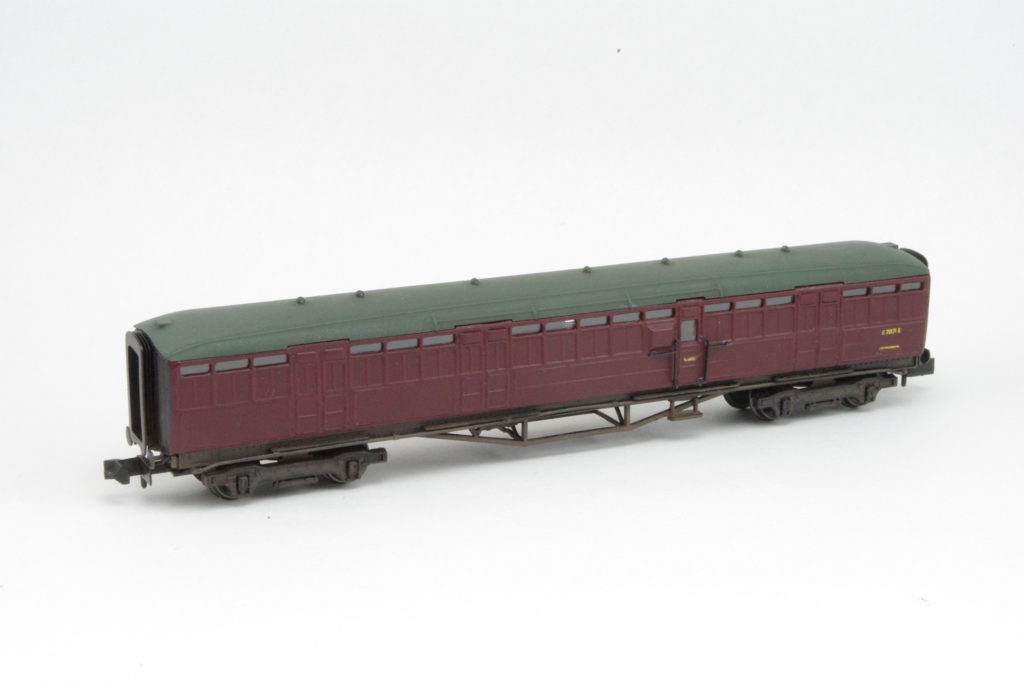
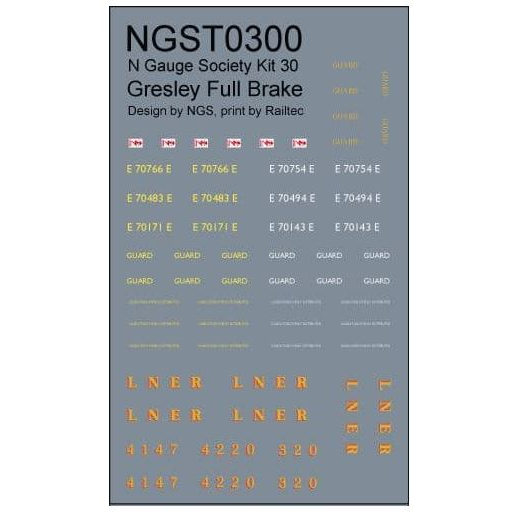
- NGSK0300
- era 4-7
- decals included but also available separately
- difficulty intermediate
The Gresley full brakes were introduced in 1924; some survived in revenue use well into the 1970s, a few even longer in internal use, and a number have been preserved. These vehicles were seen all over the country, especially in BR days, and a number were built or converted for racing pigeon traffic. The chosen model represents later coaches with angle iron trussing and 8ft heavyweight Gresley bogies. The diagrams represented are D113 (last 3 only, built 1934), D245 (with racks for pigeons, built 1940/43), and D260 (same as last 3 of D113, built 1938/40/43).
Kit 31: BR Weltrol
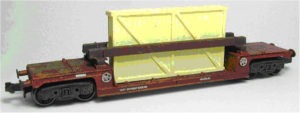
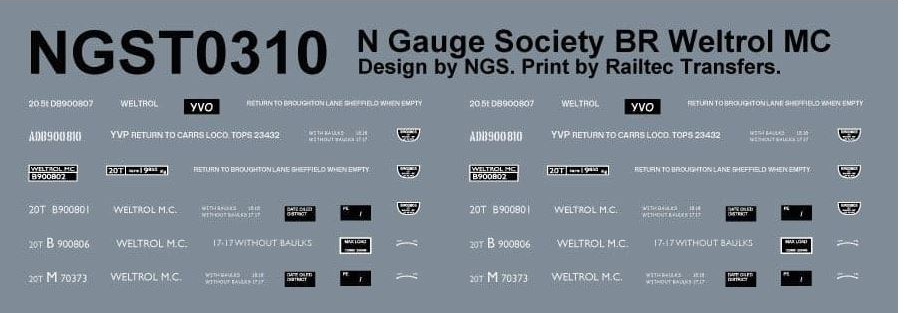
- NGSK0310
- era 5-9
- decals NGST 310
- difficulty intermediate
Many different types were built, mainly in the 1950s, but, as they were lightly used, they lasted a long time, with a few still in service in internal use. There were 22 diagrams for different lengths and loads covering a total of 107 wagons, though some differed only in brake or bearing type. The chosen Weltrol MC prototype was one of the more common, with 22 built. It was based on an earlier LMS design and is one of the shorter ones with a square-shaped well. Unlike many other Weltrols, the floor was load-bearing so it could carry vehicles, which is one reason for its popularity as a departmental wagon.
The kit includes Society 5’6” Plateback bogies (but does not include the crated load shown in the picture, which is available separately from the Society Shop – code NGSK0311).
Kit 32: GWR Macaw B

- NGSK0320
- era 3-5
- decals included but also available separately
- Difficulty intermediate
This kit represents a departure from normal practice for the Society in that the wagon body is made from laser cut wood, with a brass etch to provide brake detail. It runs on the Society’s own plateback bogies. The prototype was produced in substantial numbers by the GWR from 1907 to 1946 and many were inherited by BR.
Kit 33: Railtrack PNA Wagon

- NGSK0330
- era 9
- decals=included
- difficulty beginners
In the late 1990s Railtrack converted 250 former tank wagons into PNA open spoil carriers. 44 of them used Gloucester pedestal suspension. Of these, 22 were fitted with evenly spaced bodyside ribs, while the other 22 had a larger gap between the ribs above each axlebox. The kit is a twin pack, enabling one of each variant to be built, with self coloured green body mouldings, one piece black chassis, wheels, couplers and transfers. The picture shows weathered versions of completed models.
Kit 35: KPA Hopper, JJA/HQA Autoballaster
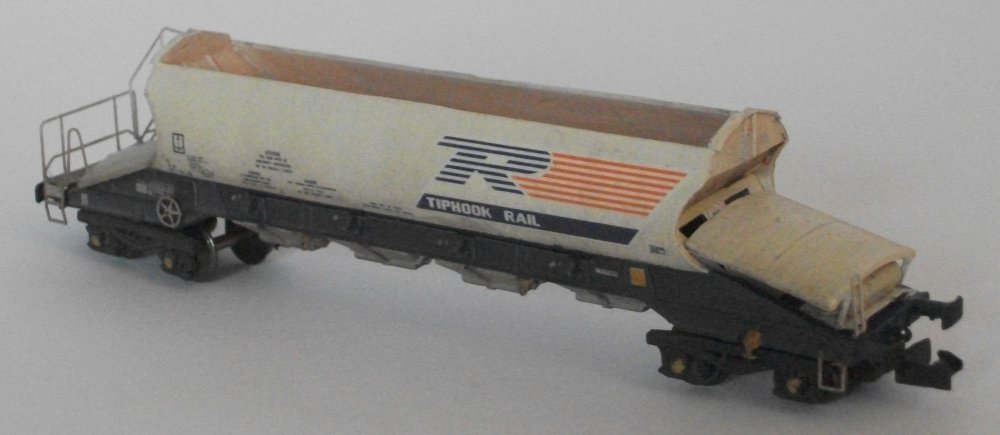
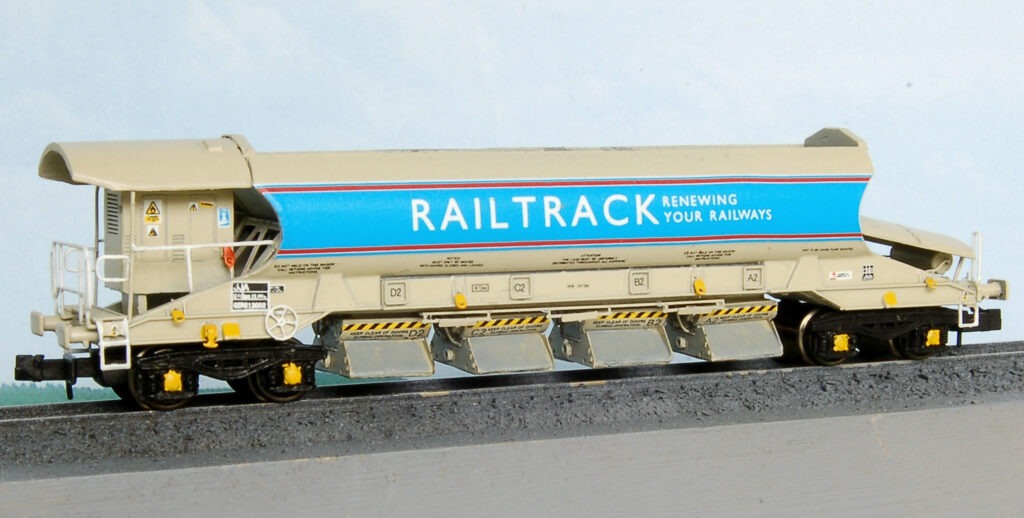
- NGSK0350 Tiphook PIA/KPA Aggregate Hopper Wagon
- NGSK0351 Railtrack JJA Autoballaster (converted from KPA)
- NGSK0352 Railtrack HQA Autoballaster (new build)
- NGSK0353 Network Rail HQA Autoballaster (new build)
- era 8-9
- decals included
- difficulty advanced
In 1988, 50 hoppers (originally coded PIA, then KPA) were built for Tiphook Rail in response to growth in the construction industry. They saw service around the network with Tarmac, RMC and Foster Yeoman, among others. In the mid 1990’s, prototype discharge gear was fitted to enable them to operate in five-vehicle sets as Autoballasters, in place of ageing Seacow and Dogfish wagons. The success of the project saw further conversions, and the purchase by Railtrack and subsequently Network Rail of considerable numbers of new wagons to an almost identical design. This kit comes in the following four versions:
Kit 36: BR Shock Wagons – Open & Van
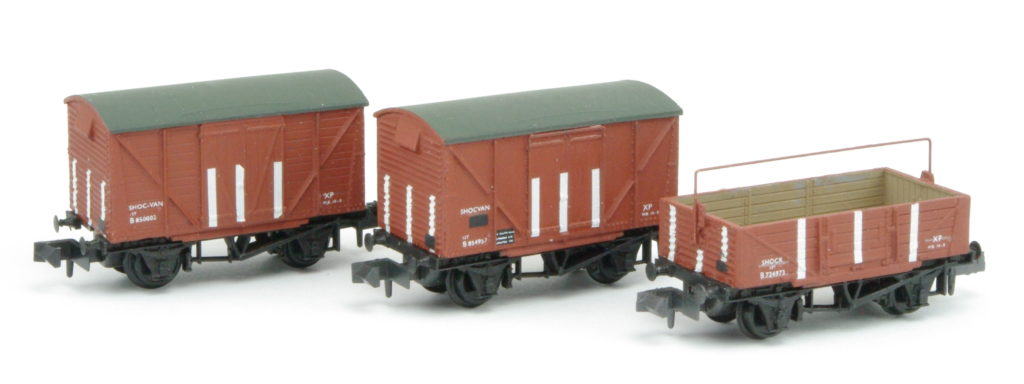
- NGSK0360
- era 4-7
- decals NGST0360
- difficulty beginner
British Railways built large numbers of shock-absorbing vans and open wagons in the early 1950s to its own designs, some remained in revenue use to the end of the 1970s. Certain fragile goods such as ceramics, bottles, and biscuits were susceptible to damage during shunting. The wagon body was connected to the chassis by means of springs on the outside of the solebars, thus absorbing more of the ‘shock’ of rough shunting than just the buffers.
The distinctive white stripes on the sides and ends were to indicate to shunters that the wagons were shock-absorbing, presumably so that they were handled with greater care. BR used both plywood and planking for the van sides, so both these types are catered for with alternative sides to make either one or the other. Shown are both Van variants and the Open (models and picture by Richard Bardsley).
Kit 37a: TTA Chemical Tanker

- NGSK0370
- era 7-9
- decals NGST0370
- difficulty advanced
In 1967/8, Charles Roberts Ltd built a batch of chemical tankers for Tank Rentals Ltd, with a through vacuum pipe, to TOPS code TTB. They were later refurbished and reclassified TTA. Both ICI Mond and Associated Octel used them to transport liquid chlorine. These tankers were built with smaller diameter barrels than the more common petrochemical tankers of the same TOPS code, and were painted white with an orange band to denote their hazardous contents.
This kit was originally based around a Farish TTA wagon, which was used as a chassis donor. A moulded brick bund wall is included, which allowed the unused tank to be used for a static depot fuel tank as a scenic accessory. Since the Farish wagon became unavailable, the kit is now supplied with a Peco chassis.
The body is moulded in self-coloured plastic so that minimal painting is required. Etched brass accessories are included. A comprehensive sheet of decals is included covering early and late ICI chlorine, Associated Octel and Hays chlorine, ICI sodium hypochlorite and caustic soda, plus two other variants for sulphuric acid and molasses.
Kit 38: BR Borail
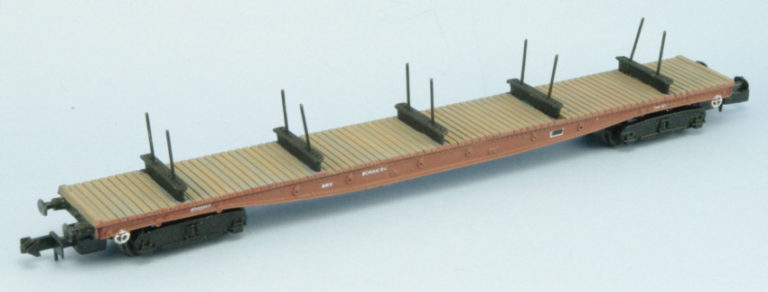
- NGSK0380
- era 5-7
- decals included
- difficulty intermediate
This kit builds a Borail EB or a Borail MB, or, if the bolsters are omitted, a Borail EC. They were built 1959-61 and lasted until rebuilt with air brakes in the late 70s (kit 39).
Kit No. 39: BR Mullet
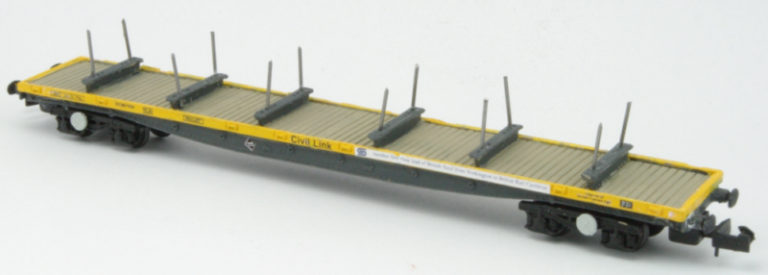
- NGSK0390
- era 7-9
- decals included
- difficulty intermediate
In the late 1970s, most of the Borails (see NGK038) were rebuilt and named Mullets. This ex-Parkwood kit is supplied with NGS Y25 bogies, decals and additional detailing.
Kit No. 46: Bobol E/YCV Turbot
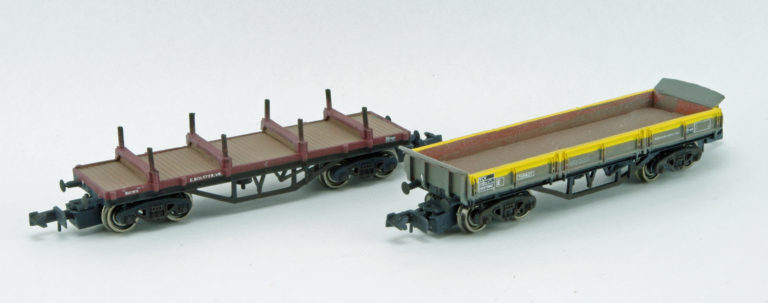
- NGSK0460
- era 5-7,7-9
- decals included but also available separately- NGST0460
- difficulty intermediate
In 1961 BR built the short Bogie Bolster E fleet to diagram 1/479 as replacements for the TWIN CASE (linked bolster wagons) and HYTWIN (modified wooden 13T wagons). It has been suggested that they struggled to find full employment from the beginning, with conversions starting almost immediately. They were used extensively on trains from South Wales to carry steel billets, which were shorter than the normal steel and rod traffic, and thus they were ideal for this traffic.
During the late 1970s, the steel traffic for which the Bogie Bolster E was built was in decline, so in the early 1980s BR embarked on a programme of converting them to 34T ballast/spoil wagons with the ‘fish kind’ name ‘Turbot’, TOPS code YCV, with over one thousand being so treated. This is an ‘either/or’ plastic kit which builds into either wagon using the same floor moulding and Society Gloucester bogies.
Kit 47: BR (ex LMS/LNER) Highfits
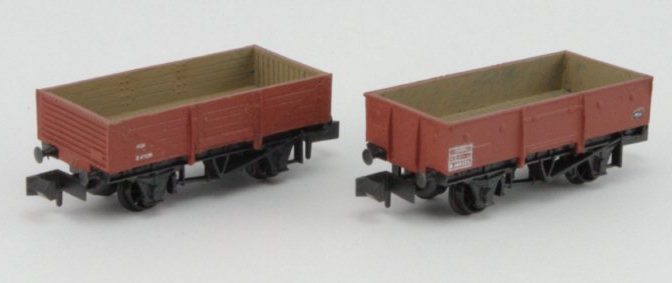
- NGSK0470
- era 4-7
- decals=NGST0470
- difficulty beginner
This kit will make two wagons – a BR (ex-LMS) Highfit open wagon with planked sides and corrugated ends and a BR (ex-LNER) all steel Highfit. The basic 5 plank open goods wagon was built in large numbers by all railway companies prior to the 1923 grouping, by the big four themselves after this date, and it continued with British Railways after nationalisation.
The wooden ends were susceptible to damage from heavy loads moving during shunting so in 1946 the LMS changed to wood lined corrugated steel ends which they had tried on a few experimental wagons in 1933.
The LNER’s answer in 1945 was an all steel body (albeit still with a wooden floor). Both designs were initially manufactured without vacuum brakes, but as British Railways continued making them to more or less the same design, they started to introduce vacuum brakes, and retrospectively started fitting them to the early builds. Some of the robust LNER wagons even survived long enough to be converted to air brakes.
The decal sheet includes transfers for pre-nationalisation, British Railways, BR (TOPS) and the final use of these wagons in engineering service. Both kits are a reissue from the former Parkwood Models range that was acquired by the Society.
Kit 48: LMS/GWR Open Wagon
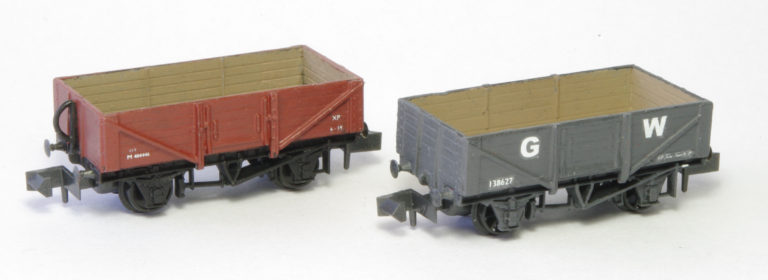
- NGK0480
- era 3-7
- decals included but also available separately- NGST0480
- difficulty beginner
This wagon was the commonest type on BR after mineral wagons. In all nearly 40,000 all-wood opens were built from 1933 to 1950. They were used for goods of all kinds – crates, sacks, planks, barrels, drums, castings, boxes, vegetables – but never coal or other mineral traffic. They frequently had tarpaulins (sheets) over them to protect the load. They are under-represented on most steam era layouts, as until the end of steam they were more common than 12T vans. In 1967 many were reallocated to china clay traffic. Some wagons lasted into the late 70s in revenue use, and they were popular departmental wagons.
This twinpack kit is provided with two Peco 10’ chassis, and transfers that cover GWR, LMS (pre and post 1935 style), BR fitted and unfitted, later BR markings with boxed numbers, and a selection of departmental markings. It makes a pair of similar 5 plank open wagons with wooden ends as well as sides, LMS design 1892 and GWR diagram O32. They are 5 ½ standard 7” planks high: to give the extra height the next to bottom plank on the GWR wagons is 11” deep, and on the LMS the top and bottom planks are 9” – this is the only real difference between the two. Both feature the ‘barrow plank’, in which the bottom plank of the door is angled out to make it easier to wheel barrows in and out.
Kit 49: WD Warflat
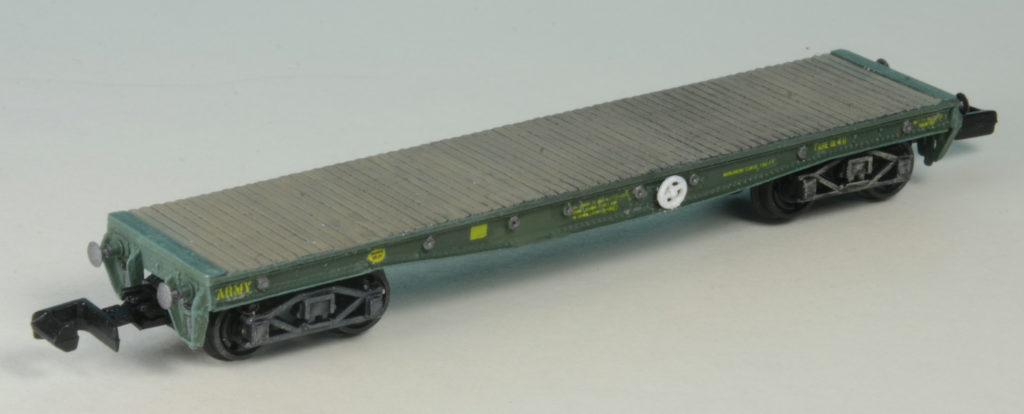
- NGSK0490
- era 3-7
- decals=NGST0490
- difficulty intermediate
Ex Parkwood Models kit depicting fishbelly warflat design used by the army from WW2 to mid 1970s. Many were sold to BR or British Steel and some were still in use in 2015. Supplied with diamond frame bogies.
Kit 50a: WD Warwell
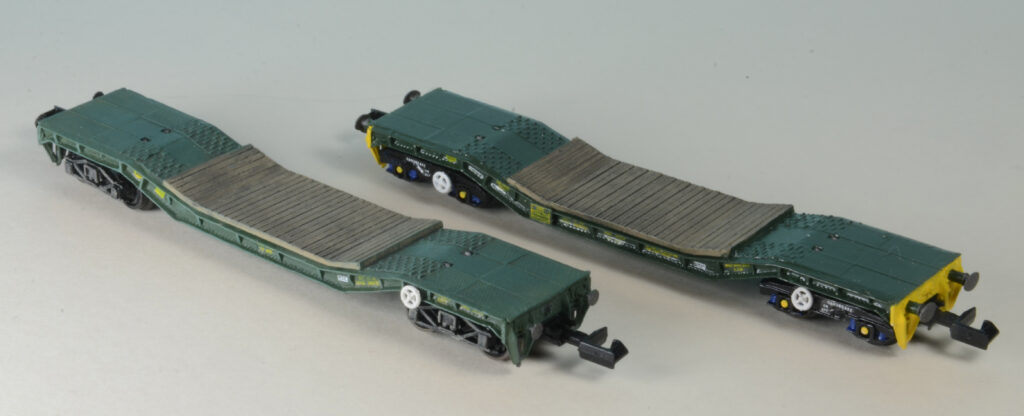
- Pre-1976
- NGSK0500
- era 3-7
- decals=NGST0500
- difficulty intermediate
- post 1976
- NGSK0501
- era 7-9
- decals=NGST0501
- difficulty intermediate
Ex Parkwood Models kit representing type used from WW2 to late 1970s. The kit (below left) is supplied with diamond frame bogies. In the late 1970s these wagons were all re-bogied and refurbished. The kit (above right) includes Gloucester GP22.5 bogies.
The parts need a little filing to get a good fit, so not recommended for a beginner.
Kit 51: GWR P19/BR ‘Rudd’ Ballast Wagon
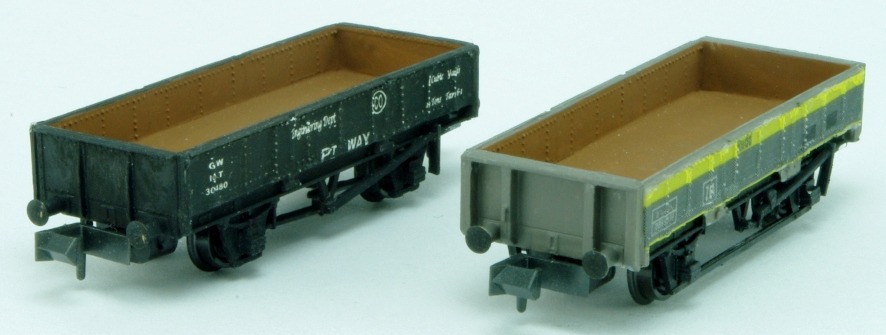
- NGSK0510
- era 3-7,8-9
- decals=NGST0510
- difficulty intermediate
Kit with alternative ends to enable building various vacuum braked ballast wagons, the GWR P19/BR Ling built 1941-9, or a BR Tunney or Grampus. It also makes a BR Rudd air-braked wagon, introduced from 1989 as rebuilds on redundant chassis and of vacuum braked wagons, they remained in use until 2008.
Kit 52: Macaw C/Borail C

- NGSK0520
- era 3-7
- decals=included
- difficulty intermediate
Laser cut wood kit includes brass etches and 5ft 6in plateback bogies. The prototype was a 70ft long wagon. Two of these wagons were built by the GWR 1912-14.
Kit 53: Gane A/Macaw J/Borail F
- NGSK0530
- era 8-9
- decals=included
- difficulty intermediate
GWR’s standard rail carrying wagon built from 1935, they lasted into the 1980s.
Kit 54a: KSA Rover ‘Cube’ Wagon

- NGSK0540
- era 9
- decals=included
- difficulty intermediate
The prototype wagons were manufactured by Rautaruukki of Finland in 1995 for the Rover car company for the secure transportation of car components between plants. In more recent years, they have been used in partnership by DRS and logistics firm W H Malcolm on Anglo-Scottish freight services and two were repainted to reflect this. The kit includes one-piece injection moulded bogies, etched detail parts and decals.
Kit54b: KSA NACCO Timber Wagon
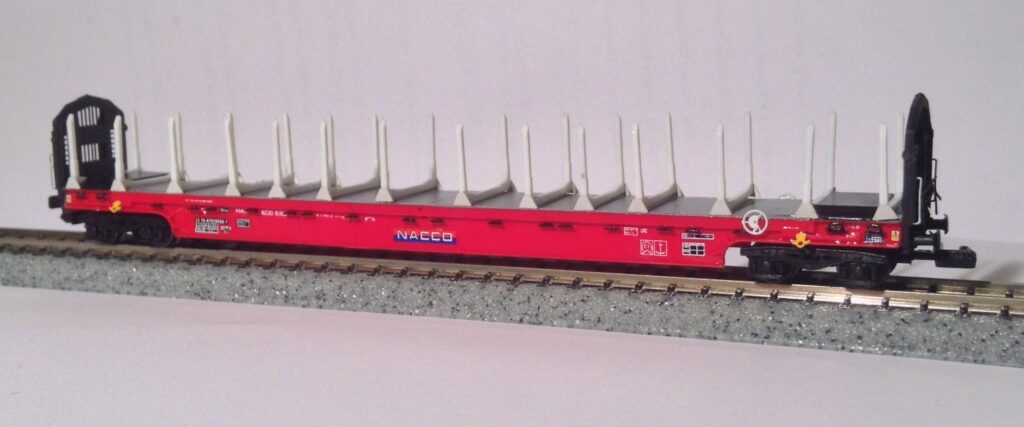
- NGSK0541
- era 9
- decals=included
- difficulty advanced
In 2011, a batch of KSAs was acquired by wagon leasing firm Nacco and converted for use as timber carriers; this involved replacing the sliding hoods with heavy-duty stanchions. The wagons have been repainted and are now in service with Colas on timber traffic from Cornwall, South Wales and the North to a paper and board factory at Chirk. This kit also includes a set of injection moulded stanchions.
Kit 61: BR ‘Vanwide’ Van
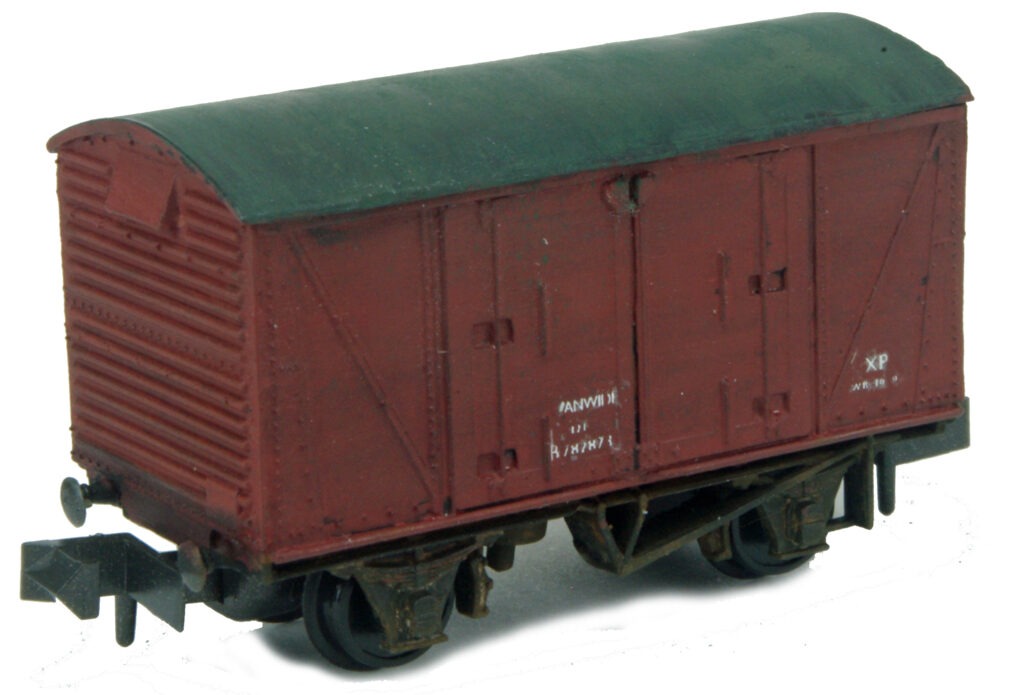
- NGSK0610
- era 5-8
- decals=NGST0610
- difficulty beginners
Ex Parkwood Models kit of a distinctive BR designed van with wide-opening doors to cater for palletised loads and forklift trucks. About 2000 were built in 1962 as a replacement for the unsuccessful Palvan, these vans were very successful and remained in service into the 1990s, though most by then had been upgraded to air brakes.
Kit 62: BR A & BD type Containers

- NGSK0620
- era 4-6
- decals=NGST0620
- difficulty beginners
Ex Parkwood Models kit. Standard small and large general goods containers, between 1949 and 1959 BR built nearly 5000 of the type A containers and over 10000 of the type BD containers, so they were very common. Assembly of the kit is very simple. They were made obsolete by more modern designs that locked onto the wagon, though some survived in use until the late 70s.
Kit 63: BR Palvan/Medfit
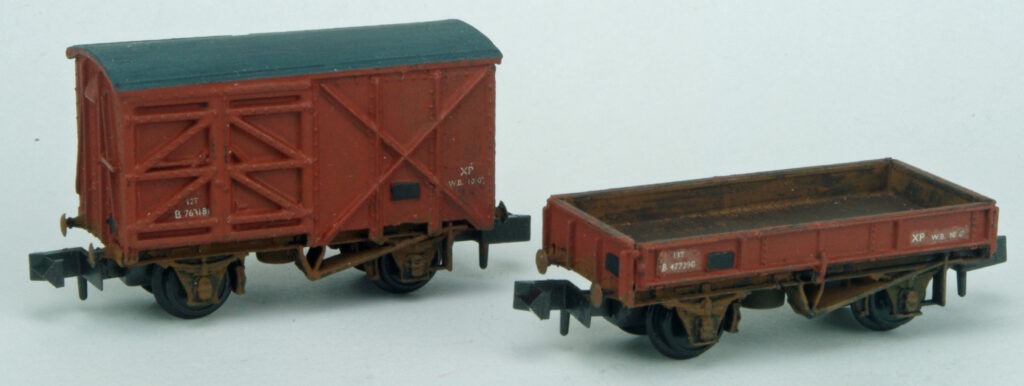
- NGSK0630
- era 5-7
- decals=NGST0630
- difficulty beginners
Ex Parkwood Models kit. A twin pack of a Palvan and a medium steel open wagon. The BR Palvans were an innovative and unusual design for carrying pallets of goods loaded by fork lift trucks, and had specially wide doors to allow access. Nearly 2,400 were built 1954-57, but as the chassis wore they became unstable at speed, and from 1962 were largely replaced by the Vanwide design (kit 61). BR built about 4000 all steel medium height fitted open wagons 1952-5 with drop sides, but the traffic they were intended for soon disappeared. They were however ideal wagons for the engineers department, and most had been transferred by 1970.
Kit 64: BR Sand Tippler/Coil J
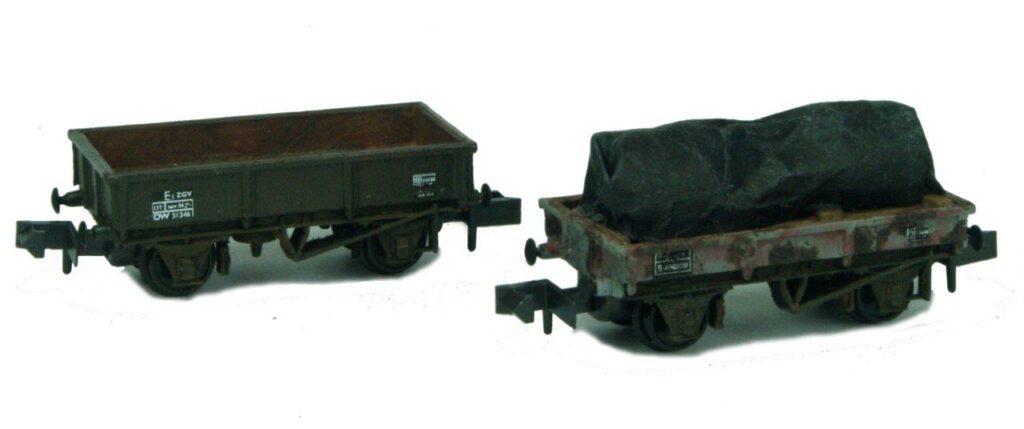
- NGSK0640
- era 5-7
- decals NGST0640
- difficulty beginners
Ex Parkwood Models, a twin pack of a sand wagon and a Coil J. BR built 100 sand wagons with 10 foot wheelbase wagons in 1957, they were withdrawn around 1980. 750 similar wagons with 9 foot wheelbase were built 1950-1. The Coil J wagons were built in 1960 on redundant iron ore tippler chassis for carrying coiled strip steel, they were the last unfitted wagons used on BR, lasting until the mid-80s.
Kit 65: SR 8 Plank Open Wagon
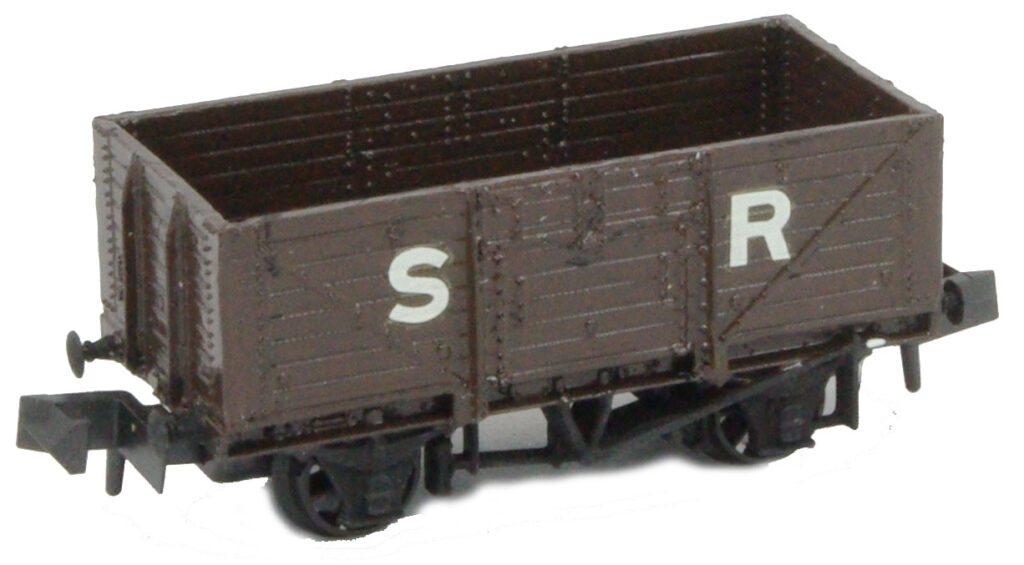
- NGSK0650
- era 5-7
- decals=NGST0650
- difficulty beginners
Ex Parkwood Models kit. These 10 foot wheelbase wagons were built 1936-7 and lasted in revenue service well into the 1960s, the last being withdrawn in 1970. Though classified as goods wagons, the SR used some of them for coal traffic, particularly in Kent.
Kit 66: BR Lowfit/Twin Bolster

- NGSK0660
- era 4-7
- decals=NGST0660
- difficulty beginners
Ex Parkwood Models kit. This twin pack will build either two BR Lowfit wagons, or a permanently coupled Twin Bolster pair of wagons. BR built 2750 steel lowfit wagons 1950-7, they were in use into the 80s. The later builds had more ribs on the side, the kit builds one of each type. In 1961 BR converted redundant lowfits to permanently coupled twin bolsters for carrying steel, these lasted into the 1980’s.
Kit 67: LNER 12T Vans
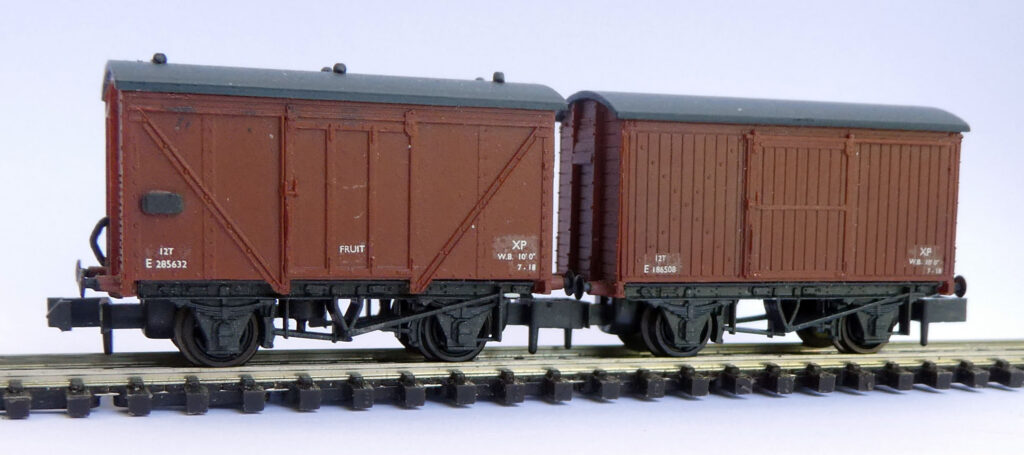
- NGSK0670
- era 3-7
- decals=NGST0670
- difficulty beginners
Ex Parkwood Models kit. Twin pack, builds two LNER vans, one with planked sides and one with ply. Alternative ends are supplied for fruit vans. They were built around 1935 and lasted unto the mid-70s.
Kit 68: POA/PNA ‘Tiger’ Open
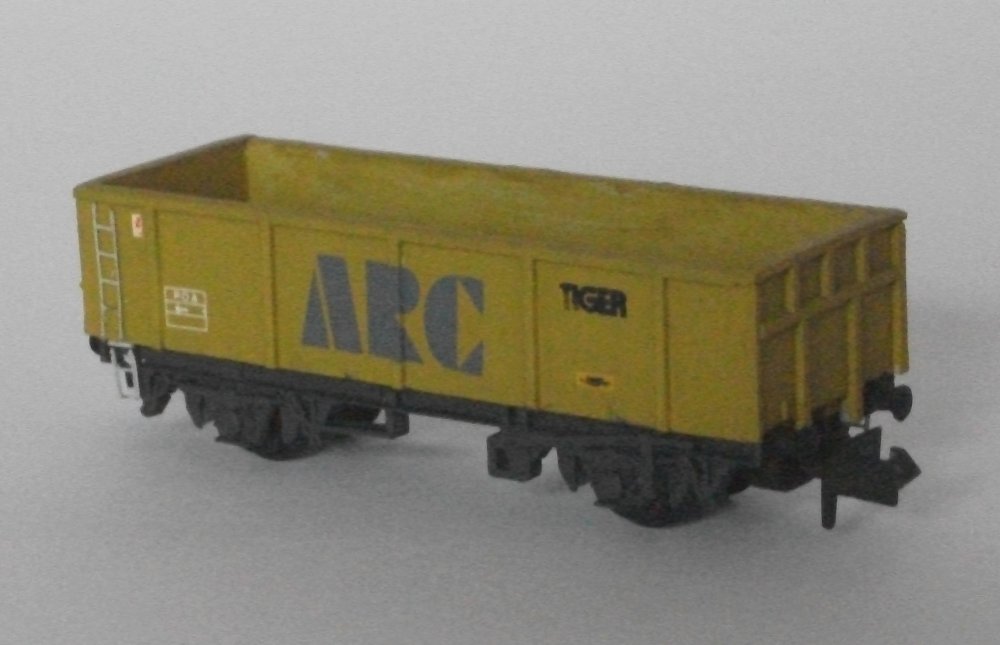
- NGSK0680
- era 8-9
- decals=NGST0680
- difficulty beginners
Ex TPM kit. New bodies built by CC Crump for Tiger Rail 1987-8 on old tank wagon underframes. Most were used to carry aggregate, some were used for scrap metal. From mid-1993 most were converted to Limpet spoil wagons (kit 69).
Kit 69: ZKA Limpet
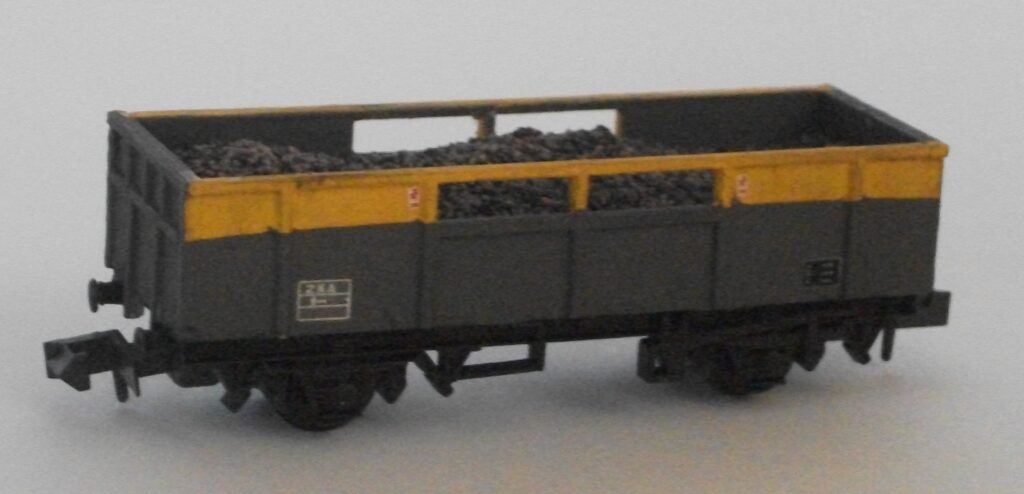
- NGSK0690
- era 8-9
- decals=NGST0680
- difficulty beginner
Ex TPM kit. Spoil wagon, converted from POA/PNA open wagons in 1993.
Kit 70: BR Standard Vans
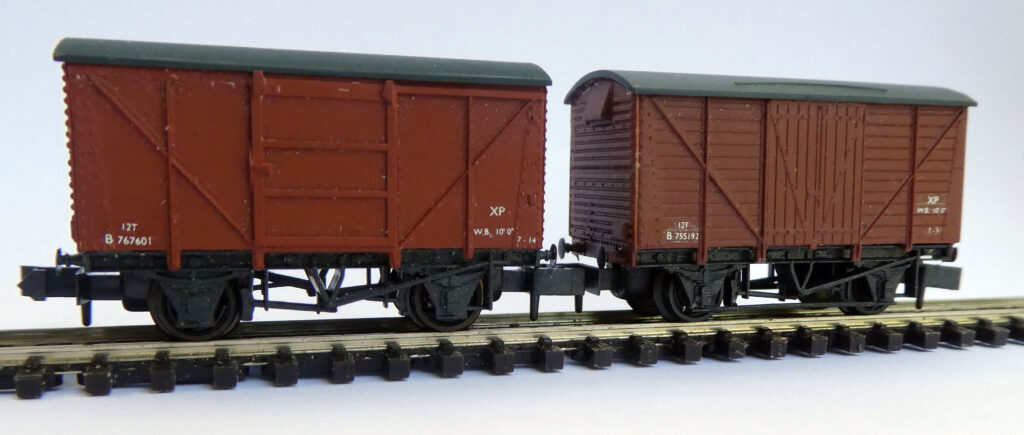
- NGSK0700
- era 4-7
- decals NGST0680
- difficulty beginner
Ex Parkwood Models kit. BR standard vans built 1951-7, this twin pack builds one with planked sides and one with the less common ply sides. They lasted into the 1980s. Includes alternative ends to build an insulated meat van or ventilated meat van.
Kit 71b: ‘Russell’ Coal Container
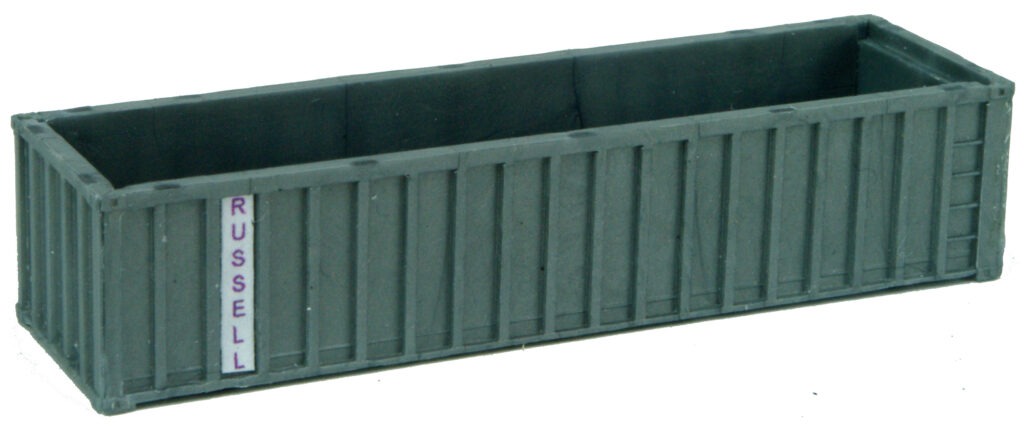
- NGSK0711
- era 8-9
- decals available from C-Rail intermodal sheet number 7.
- difficulty beginner
Ex TPM kit. From 1984 these containers were carried on container wagons converted from VCA Vans and SAA bolsters, they were in use at least until the 2010’s.
Kit 72: PTA/JTA/JUA Bogie Iron Ore Tippler
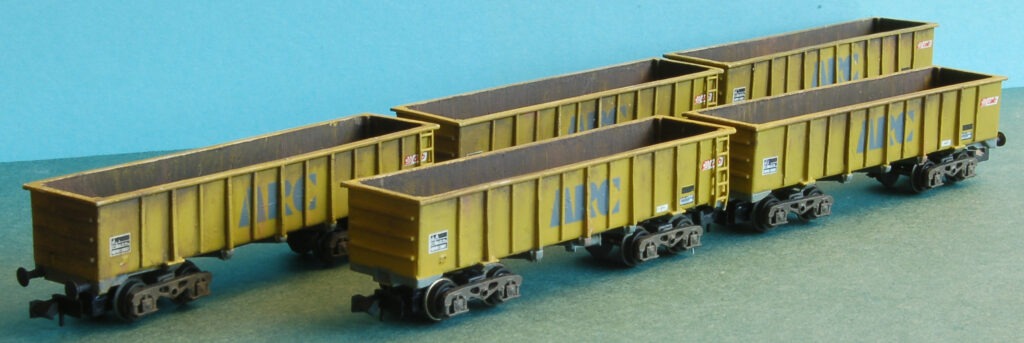
- NGSK0720
- era 7-9
- decals=NGST0720
- difficulty intermediate
Ex TPM kit. This kit is made available in packs of five. These wagons were built 1972-7 for carrying iron ore to British Steel plants and ran in long fixed rakes. When steel plants closed they were sold off and mainly used for carrying aggregates, still in long rakes, in use into the 2010s.
Kit 74 BR China Clay Wagon

- NGSK0740
- era 4-8
- decals NGST0740
- difficulty intermediate
BR built 875 of these wagons between 1954 and 1960. Originally they were restricted to Devon and Cornwall but later went further afield. The design was based on almost identical wagons built by the GWR. In the 1970s most were fitted with distinctive blue ‘clay hoods’, and they lasted into the 1990s. The kit is straightforward to build using a Peco 9ft chassis kit which is included.
Kit 75: BR VCA Van
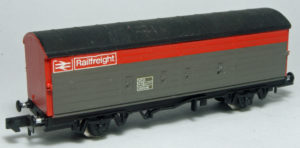
- NGSK0750
- era 7-8
- decals NGST0750
- difficulty beginners
Ex TPM kit. Converts a Farish VBA van into a VCA van, built 1971-4. They were not popular and were withdrawn from revenue use in the 1980s. .
Kit 76: BR VDA Van
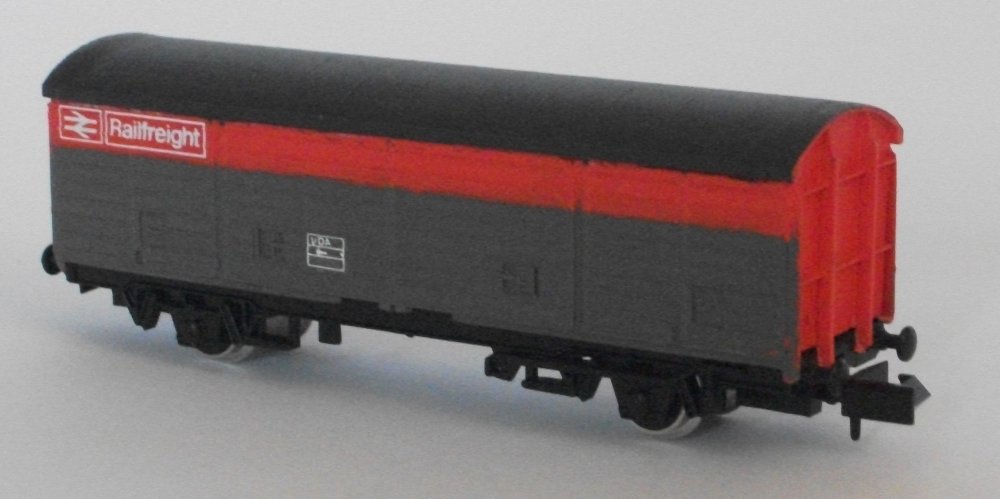
- NGSK0760
- era 7-8
- decals NGST0760
- difficulty beginners
Ex TPM kit. Converts a Farish VBA van into a VDA van, built 1976. They lasted until the early 1990s.
Kit 77: LNER-BR Boplate



- NGSK0771-3
- era 3-8
- decals NGST0770
- difficulty intermediate
Ex Parkwood Models kit. The basic Boplate design for carrying steel plate was introduced by the LNER in the 1930s, and with changes to bogies and brakes the design lasted into the 1990s. Three variants are available: LNER/BR Unfitted with diamond frame bogies, BR Vacuum Fitted with Plateback bogies, and those converted to air brakes 1979-82 which were fitted with Y25 bogies.